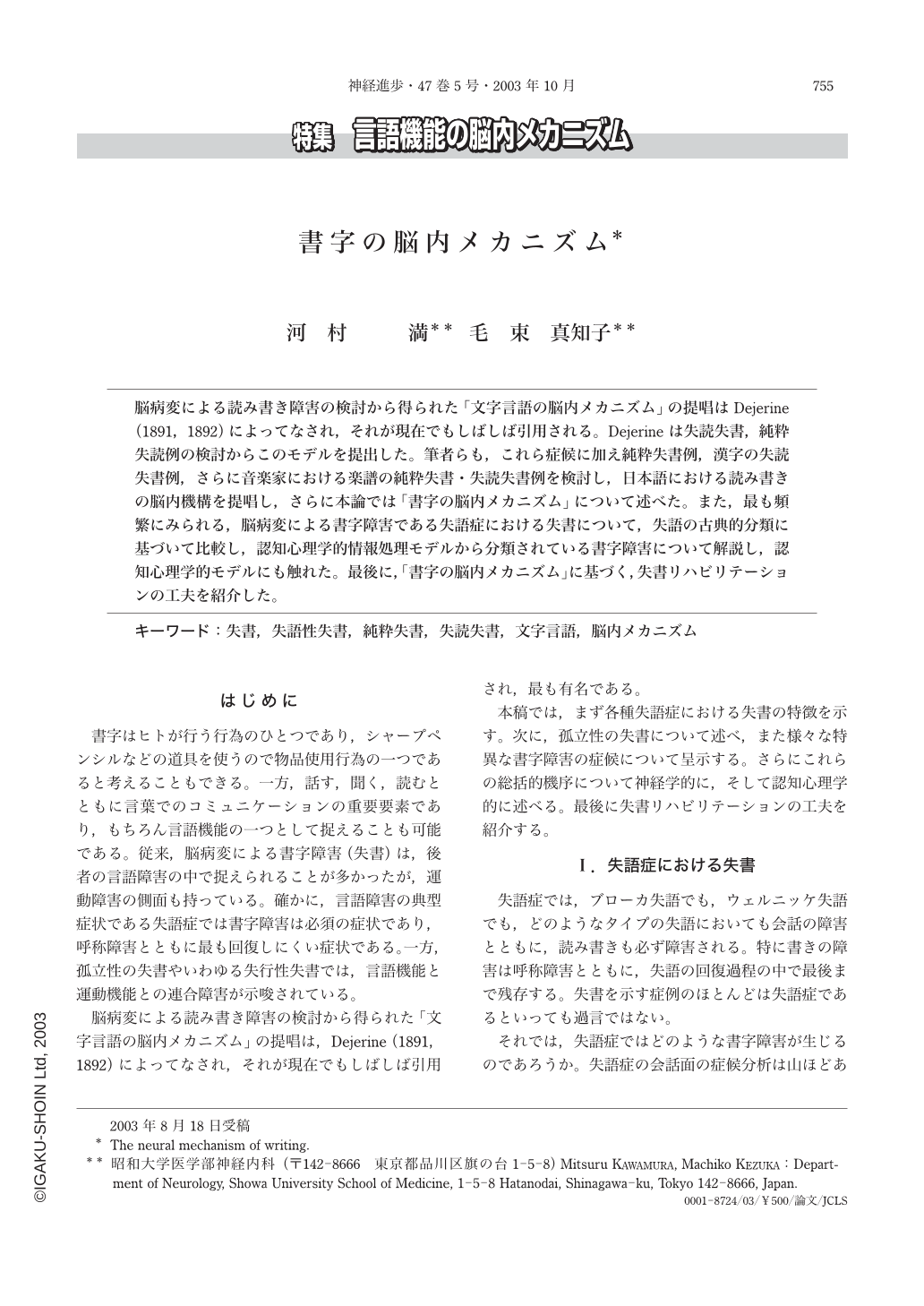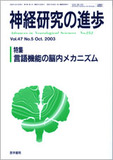Japanese
English
- 有料閲覧
- Abstract 文献概要
- 1ページ目 Look Inside
脳病変による読み書き障害の検討から得られた「文字言語の脳内メカニズム」の提唱はDejerine(1891,1892)によってなされ,それが現在でもしばしば引用される。Dejerineは失読失書,純粋失読例の検討からこのモデルを提出した。筆者らも,これら症候に加え純粋失書例,漢字の失読失書例,さらに音楽家における楽譜の純粋失書・失読失書例を検討し,日本語における読み書きの脳内機構を提唱し,さらに本論では「書字の脳内メカニズム」について述べた。また,最も頻繁にみられる,脳病変による書字障害である失語症における失書について,失語の古典的分類に基づいて比較し,認知心理学的情報処理モデルから分類されている書字障害について解説し,認知心理学的モデルにも触れた。最後に,「書字の脳内メカニズム」に基づく,失書リハビリテーションの工夫を紹介した。
はじめに
書字はヒトが行う行為のひとつであり,シャープペンシルなどの道具を使うので物品使用行為の一つであると考えることもできる。一方,話す,聞く,読むとともに言葉でのコミュニケーションの重要要素であり,もちろん言語機能の一つとして捉えることも可能である。従来,脳病変による書字障害(失書)は,後者の言語障害の中で捉えられることが多かったが,運動障害の側面も持っている。確かに,言語障害の典型症状である失語症では書字障害は必須の症状であり,呼称障害とともに最も回復しにくい症状である。一方,孤立性の失書やいわゆる失行性失書では,言語機能と運動機能との連合障害が示唆されている。
脳病変による読み書き障害の検討から得られた「文字言語の脳内メカニズム」の提唱は,Dejerine(1891,1892)によってなされ,それが現在でもしばしば引用され,最も有名である。
本稿では,まず各種失語症における失書の特徴を示す。次に,孤立性の失書について述べ,また様々な特異な書字障害の症候について呈示する。さらにこれらの総括的機序について神経学的に,そして認知心理学的に述べる。最後に失書リハビリテーションの工夫を紹介する。
The first comprehensive theory on the neural mechanism of reading and writing was presented by Dejerine(1892)with schematic diagrams. A number of studies on the mechanism of writing have been carried out since then, although none seem to have surpassed the work of Dejerine and its comprehensive content.
In the current article reviews of several types of agraphia were presented, and some comments are made from a new viewpoint. Then, carring out a different investigation which might develop Dejerine's schema of alexia and agraphia, a comprehensive hypothesis is proposed on the neural mechanism of writing.
1.Aphasic agraphia
1-1.Classical classification of aphasia:We presented the characteristics of agraphia of Broca type aphapsia, Wernicke type aphasia, conduction type aphasia, total aphasia, transcortical motor type aphasia, transcortical sensory type aphasia, mixed transcortical type aphasia, gogi aphasia, anomic aphasia and alexia with agraphia.
1-2.Recent cognitive psychological classification of agraphia:We presented the characteristics of agraphia of phonological agraphia, lexical agraphia, semantic agraphia, deep dysgraphia.
2.Pure agraphia:We presented the characteristics of agraphia with frontal lobe lesion, parietal lobe lesion, left hand agraphia.
3.Atypical type of agraphia:We presented the characteristics of apraxic agraphia, spacial agraphia, constractional agraphia, pure agraphia and alexia with agraphia of musical notes, micrographia and hypergraphia.
4.An expansion of the schemata of reading and writing by Dejerine:Based on of several types of disturbances of writing, we obtained a hypothesis on the neural mechanism of writing, and we proposed that there are two centers of writing in the left frontal lobe and in the left parietal lobe. We also introduced a recent cognitive psychological model of the writing system.
5.Treatment:Finally, we presented the new rehabilitation techniques of agraphia by Kezuka.

Copyright © 2003, Igaku-Shoin Ltd. All rights reserved.


